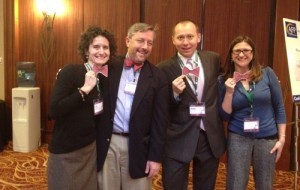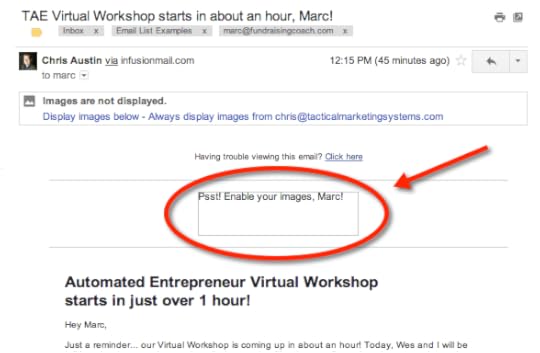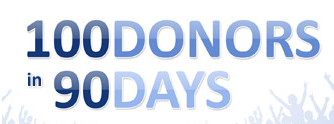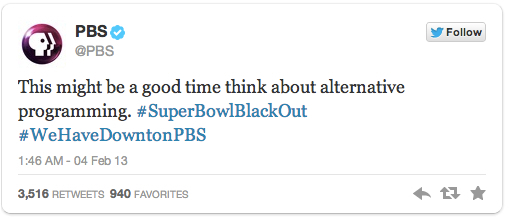Marc A. Pitman's Blog, page 48
February 7, 2013
[Question Marc] How do we get more people to open our email?
 I recently received this question from a reader in South Africa:
I recently received this question from a reader in South Africa:
Just a quick question…. Do you have any resources or help that can ensure that we get more people to read our mails? We have an extremely low rate of about 11% at the moment.
My answer: Getting more people to open your email
The best way to get effective with email is to: test, test, test. The industry calls it a “split test,” sending one message to 1/2 your list, another to the other 1/2.
I wouldn’t make them two dramatically different emails. If you change the entire email, it’s hard to isolate the tweaks that your particular readers respond well to. So send each half substantially the same email and just test little changes to see what works best.
Since getting people to open your emails seems to be an issue, try tweakingthe subject line. Send some with the current subject; send others with a question or “Did you know [something of interest]?”
Once you get more opens, you can test “calls to action” to see which links people click on.
For a fairly recent study on open rates and click rates in emails, check out this post on MarketingProfs.com.
What say you?
If you’d been asked this question, what would you have said?
Tell us in the comments!
(c) The Fundraising Coach, LLC
Get 100 donors in the next 12 weeks? Learn how: 100 Donors in 90 Days!
Other Possibly Related posts:
Question Marc
Question Marc
Help Needed: Question Marc






February 5, 2013
Future fundraising trainings?near you?
 I love speaking to groups, helping people get excited about fundraising, and helping groups communicate more effectively.
I love speaking to groups, helping people get excited about fundraising, and helping groups communicate more effectively.
My team is looking at expanding the number of trainings I do. Every month we have people asking to attend a public session near them.
If you?re interested in attending an event near you, let us know by filling out the form at: https://qc125.infusionsoft.com/app/form/training
And if you?re interested in having me speak to your conference, staff, or board, please let us know there too: https://qc125.infusionsoft.com/app/form/training
(c) The Fundraising Coach, LLC
Get 100 donors in the next 12 weeks? Learn how: 100 Donors in 90 Days!
Other Possibly Related posts:
QR Codes: The Future of Fundraising?
Fundraising Kick
Get free fundraising information in your inbox!






Future fundraising trainings…near you?
 I love speaking to groups, helping people get excited about fundraising, and helping groups communicate more effectively.
I love speaking to groups, helping people get excited about fundraising, and helping groups communicate more effectively.
My team is looking at expanding the number of trainings I do. Every month we have people asking to attend a public session near them.
If you’re interested in attending an event near you, let us know by filling out the form at: https://qc125.infusionsoft.com/app/form/training
And if you’re interested in having me speak to your conference, staff, or board, please let us know there too: https://qc125.infusionsoft.com/app/form/training
(c) The Fundraising Coach, LLC
Get 100 donors in the next 12 weeks? Learn how: 100 Donors in 90 Days!
Other Possibly Related posts:
QR Codes: The Future of Fundraising?
Fundraising Kick
Get free fundraising information in your inbox!






February 4, 2013
Did Charities Sleep Through The Great Super Bowl Blackout?
Last night the power went out at the Super Bowl for 33 minutes and 55 seconds. And brands had a field day using Twitter to add humor and garner brand recognition. CNET reports that during the blackout, Twitter activity was around 231,500 tweets per minute!
Tamsen Webster of Allen & Gerritsen and Georgy Cohen of Crosstown Digital did an amazing job of finding and retweeting the best. Some that stick out for me were:
Oreo’s tweet “Power out? No problem” tweet with the image attached that said “You can dunk in the dark” was brilliant. (AdAge reports that one tweet was retweeted 10,000 times in just one hour!)
Audi’s tweet about sending LEDs was tied directly to its brand. (And a swipe at their competitor, Mercedes Benz, who’s name was on the Super Dome!)
And the Major League Baseball tweet hijacked the world’s most watched sporting event, American football, to remind everyone that baseball spring training starts in 8 days!
Someone even took the initiative to start a new Twitter account @SuperBowlLights and gain thousands of followers and retweets in that half an hour.
Where were the nonprofits?!
The only nonprofit tweets I saw were from Love146 and PBS. Both responded with humor.
Love146
Rob Morris, president and co-founder of Love146 made a humorous Pink Panther reference in a tweet. This was a good use of Twitter since it’s almost always great for nonprofit leaders to show they have a sense of humor. The old axiom is true: people give to people. So proving you’re a person with personality is a vital step in increasing donor loyalty.
Here’s his tweet:
The Superbowl trophy is GONE! #pinkpantherstrikesagain
— Rob Morris (@ROBLOVE146) February 4, 2013
PBS‘ tweet took personality to a whole new level. Anyone that has done social media for an organization knows that it’s tough to find the organization’s “voice,” let alone find one that is a bit quirky.
PBS
What did your nonprofit do?
Companies reportedly spent around $4 million per 30-second spot. But with the nimble use of Twitter alone, companies like Audi and Oreo are getting media attention today for free. In an age of a 24/7 news cycle, agile nonprofits have an unprecedented opportunity to get media attention. But it’ll take timing and usually humor.
Did your nonprofit have some fun tweets? Tell us about it in the comments?
(c) The Fundraising Coach, LLC
Get 100 donors in the next 12 weeks? Learn how: 100 Donors in 90 Days!
Other Possibly Related posts:
Nonprofit Fundraising Super Secret Page for HARO Readers
Great reason to NOT fundraise with Facebook
Give a goat! A great social media call to action






February 1, 2013
Nonprofit Blog Carnival: How do you keep your donors wanting to come back?
I am honored to have FundraisingCoach.com host February’s Nonprofit Blog Carnival!
Last month the Carnival looked at Your Big Dream for 2013. This month, we’re asking: how do you keep donors engaged for a second gift?
According to studies in the USA, the average nonprofit loses an astounding 70% of donors each year. That means every year, 7 out of 10 donors don’t give again. Businesses would go bankrupt with this poor retention. And in these trying economic times many nonprofits are too.
Write your post and submit it for consideration
If you’re game to play, write a post about what you do to increase donor retention. To keep donors wanting to stay connected with your nonprofit. Then email that post to the Nonprofit Blog Carnival at nonprofitcarnival@gmail.com.
The team will look over all submissions and share the best on Wednesday, February 27 here on FundraisingCoach.com.
Anyone can play! Whether your blog is large or not-as-large-as-you-would-like, whether you see yourself as a newbie or a veteran, there are no excuses. If you write a post, submit it! You’ll be in a cool group of writers. You’ll be helping nonprofits raise more money and reduce costs. And you’ll be driving traffic back to your site. It’s a “win” all around!
Send your posts before the end of day Monday, February 25
We look forward to your submissions! It’s as easy as:
Write a blog post on some aspect of what you do to help donors make a second gift.
Send it to the Nonprofit Blog Carnival at nonprofitcarnival@gmail.com before Monday, February 25. (include the permalink of your post, your name and blog name)
Check back here at the end of February to see loads of posts with great donor retention ideas!
Notes from the Nonprofit Blog Carnival Organizers
We now have an easy way for people to sign up for those reminders. Just go to: http://eepurl.com/tbGNb.
What Is the Nonprofit Blog Carnival?
Learn more about the Nonprofit Blog Carnival at: http://nonprofit.about.com/od/resources/a/nonprofitblogcarnival.htm
To see past months, check out the Nonprofit Blog Carnival Archives at http://nonprofit.about.com/od/resources/a/Nonprofit-Blog-Carnival-Archives.htm.
(c) The Fundraising Coach, LLC
Get 100 donors in the next 12 weeks? Learn how: 100 Donors in 90 Days!
Other Possibly Related posts:
How do you take care of yourself? | Nonprofit Blog Carnival
Nonprofit Blog Carnival – Self-care for nonprofit staff and fundraisers
Carnival of Nonprofit Consultants






January 29, 2013
3 ways fundraisers can slow the revolving door
 Last week, I mentioned the new report by CompassPoint called UnderDeveloped: A National Study of Challenges Facing Nonprofit Fundraising that is getting lots of press. Two of the findings the press and bloggers are reporting on are:
Last week, I mentioned the new report by CompassPoint called UnderDeveloped: A National Study of Challenges Facing Nonprofit Fundraising that is getting lots of press. Two of the findings the press and bloggers are reporting on are:
more than half of all fundraisers want to leave their job, some even to leave the entire field of fundraising, and that
about 25% of CEOs want to fire their fundraiser.
I think we can do better than this. I think we can create organizations that have happy CEOs and fulfilled fundraisers. Last week, I wrote about 3 Ways CEOs Can Slow the Revolving Door. This week, I’m writing to fundraisers.
3 ways to have the job of your dreams
Get religious about tracking your time
When I was the one person development shop for a rural hospital, I developed the habit of tracking my time. I got “religious” about putting everything I did on my Outlook calendar. Then each month, as I’d prepare my board report, I reviewed my month and recorded the hours on an Excel spreadsheet. That helped me easily run the percentages of my time devoted to each task.
This exercise wasn’t to penalize me. I wanted to get a realistic idea of where my time was going. It also gave me a ready answer if my boss got annoyed by not seeing me in my office. (It’s really hard for bosses to realize that butts-in-seats don’t meet fundraising goals.)
Since I wore many hats, my categories of time were:
Annual Fund: I included all aspects including drafting letters, working with the mailhouse, sending thank you notes, etc.
Major Gifts: This is what I loved doing, and I knew it was the best way to guarantee I reduced my cost to raise a dollar ratio.
Capital Campaign: We’d finished a campaign but there was still campaign work like pledge reminders. I also included the seemingly never ending list of capital fundraising projects in this category.
Special Events: I took over the existing bikathon but under the CEO’s leadership we killed that program and started a gala instead. Any detail that was related to that–negotiating with the orchestra and venue, printing books, organizing the volunteer committee, etc.–was tracked to this category
Community Relations: We were a small hospital in a rural community so attendance at community events and service clubs was helpful both to the hospital and to my relationships with prospects. I wanted to capture the time spent on these important tasks. Since they weren’t directly fundraising related, I could reign it in if need.
Non-fundraising Hospital Meetings: This included things like staff trainings, department director meetings, my work with the internal leadership institute. Anything I had to do as a “team member” and manager at the hospital.
We always measured our cost to raise a dollar within each fundraising category using the appropriate portion of my salary as an expense. This helped us track honestly.
When you do this, try to balance the number of categories with as many as you need to be specific but as few as possible to be helpful. If your CEO isn’t supportive yet, I’d recommend just doing this on your own for six months or a year to see where your time is going. Six months or a year in fundraising will most likely help you hit a couple direct mail appeals and a special event or two.
You might be surprised where your current time is going. I found this tool to be helpful in keeping me on track during the day. And since it was my own guide, it didn’t feel “Big Brother-ish.”
Grow a spine
What use would I be as a coach if I didn’t kick you in the butt every now and then?
Seriously, I’ve talked with so many fundraisers that are pulled in more directions than snakes on Medusa’s head. I’ve joked about wanting to create an expanding hat rack that I could give fundraisers as a gift.
I think the “problem” is that we like to help. We really want the best for the place we work. So we pitch in wherever we can. At one job, I got tremendous pleasure out of fixing the IT issues in the office. Someone have a problem printing? Fear not, I’d come flying out of my office and make it right.
The problem is, I wasn’t being graded on IT issues. That was someone else’s job. And no matter how great it felt to help, and no matter how grateful the team was that I helped, the school wasn’t paying me for that. They were paying me to raise money.
So I had to develop a spine and not jump at every computer need.
Computers might not be your thing. But I’ve seen fundraisers work on new employee orientation, bake sales, staff parties for other departments, gardening, cooking, and all sorts of crazy things.
If your boss asks you to do something and you say “yes” every time, he or she will have no idea that you’re not able to complete your work. So get a spine and learn to say “no” to none specific things. Sure “other tasks as assigned” is in your job description, but you are an adult. You need to politely speak up for yourself.
One new fiscal year my boss came to me with a whole list of “top priorities” for my job to focus on in the new fiscal year. The awful thing was each of these by themselves were excellent. Things the program needed to be done. But they weren’t “by themselves.” They were being piled onto an extremely full job.
So I took a legal pad and listed all of my current responsibilities down the left. Then I listed each of the new responsibilities on the right. I set up a meeting with her and said, “I need your help.” I showed her the lists and told her I could make an argument for why each task was an “A1″ priority. But I only had 24 hours in a day so I needed to know if there were some things on the left that I could take off my responsibilities.
Next I asked her which tasks she thought were more valuable than the others. “When an alum calls on the phone, I need to know if it’s more important that the alum speaks to a human or that the grant proposal gets completed.” Both are important, but one had to trump the other in head-to-head competition.
It was scary to ask but it sparked a great discussion that continued on during the year.
So grow a spine.
Get educated
I told this to the CEOs too. But I also told them that just as they wouldn’t tell their heart surgeon how to do his job, they should get out of the way and let you do yours.
But that requires you to be at heart surgeon excellence about fundraising. This will involve investing time and effort. But it’s worth it.
Here are some places you can look for education. As with the list for the CEOs, some of these I believe in so strongly they are tools I’ve created or have a business relationship with.
Chronicle of Philanthropy’s Daily Emails
Your CEO and your board will look to you to see how things are going. They need you to know if what your organization is experience is typical or not. They need you to interpret for them.
The Chronicle’s daily emails help you do that. Every day you get links to a few articles from the Chronicle and a few to philanthropy related articles in other news media. This is gold for you. And it’s free.
To set up your free account, go to: http://philanthropy.com/myaccount/createfreeaccount. (I decided to get a paid subscription this year. The paper editions come out far faster than I can read but the Chronicle team does amazing work for our industry and deserves our support.)
The Ask Without Fear! free newsletter
Published continuously since 2003, my own free newsletter brings to you the best I can find on tools, techniques, and tactics. You’ll get the best of what I’m learning delivered directly to your inbox.
To see what others are saying about it, and to claim your free subscription, go to: http://fundraisingcoach.com/subscribe/
Movie Mondays
Another terrific free tool is www.MovieMondays2.com. Every week, the Movie Mondays teams sends a video on some aspect of fundraising right to your inbox. These aren’t “theory.” These 5-10 minute videos are of staff, board members, donors, or foundation officers telling actual stories about effective fundraising. You’ll get a lot of great ideas right at the beginning of your week!
To learn more and to sign up, go to: www.MovieMondays2.com.
Distance Learning
There are an increasing number of services that provide education right at your desktop. Some of these ones I’ve personally helped create. For lack of a better term, I’m calling it “distance learning.” Here they are:
FundCoaches.com : The creators of FundCoaches pulled together people like Tom Ahern, Simone Joyaux, Ted Hart, Guy Mallabone, Marcy Helm, and me. They told us to deliver our best but to do it in 20- and 30-minute chunks. This is CFRE accredited education right at your desk. Still in beta, you can see the current course offerings in the “store” at FundCoaches.com.
100 Donors in 90 Days : We gathered a dozen of the best fundraising experts around the world to create a program that will help you get 100 donors in the next three months. You get interviews with the experts and detailed step-by-step guides to help you put the ideas into practice. To see the success nonprofits are experiencing, go to: www.100DonorsProgram.com.
: While attracting new donors is important, the real money is in keeping those who’ve already given. Did you know that on the average 7 out of 10 donors in the United States doesn’t give a second gift to a nonprofit? This project will help you stem to tide. Noted scholar Adrian Sargeant says even a 10% increase in retention can have a 50% increase to your over all annual funding! This project is slated to be released later this year. To learn more, go to: http://www.501videos.com/donor_retention.html
Ask Without Fear! DVD : I went into the studio to record the principles of my book Ask Without Fear! . This is great for learning about your profession and for training your board. You can learn more at www.FundraisingCoachDVDs.com. (To learn more about the board retreat-in-a-box, go to: www.BoardRetreatPacks.com.
CharityHowTo.com : The webinars produced by CharityHowTo have to reach a very stringent quality. And they cover a wide range of topics from nonprofit communications, to Facebook, to asking, and more. These are well worth your time. To learn more, go to: www.CharityWebinars.com.
AskingMatters.com : Asking Matters has a free assessment that helps you identify what “type” of solicitor you are. This will free you up to ask in the ways best suited to you. This is great for your CEO and board too. If you want more, check out the new book Asking Styles: Harness Your Personal Fundraising Power.
Lots more
That’s a start at the three things I’d recommend. The learning opportunities didn’t even include the important professional conferences like international and local chapters hosted by professional associations like
January 25, 2013
The Art of Fundraising – as a 140 second Icarus Presentation
 Wednesday, I had the opportunity to join over 375 people to hear Seth Godin speak at MIT. He was sharing ideas from his new books The Icarus Deception: How High Will You Fly? and V Is for Vulnerable: Life Outside the Comfort Zone.
Wednesday, I had the opportunity to join over 375 people to hear Seth Godin speak at MIT. He was sharing ideas from his new books The Icarus Deception: How High Will You Fly? and V Is for Vulnerable: Life Outside the Comfort Zone.
After he spoke, he invited six of us to give an “Icarus Presentation.” This was a 140 second talk on our art.
So naturally, I chose the art of fundraising!
My Icarus Presentation on Fundraising
 140 seconds goes quickly! But, to the best of my knowledge, this is a pretty faithful transcript of what I said:
140 seconds goes quickly! But, to the best of my knowledge, this is a pretty faithful transcript of what I said:
How many of you have ever asked someone to give money to a nonprofit? [More than half raised their hands]
How many of you enjoyed it? [Some laughter; some groans.]
In the next few seconds, I want to help you reframe that. Please take out a piece of paper and write down the name of a nonprofit that you wish had more resources to fund its mission. [Paused]
When I started fundraising in the mid 1990s, I was told I was a professional beggar. Or a “chugger”–a charity mugger, someone who bonked people on the head and tried to grab their wallet.
But I’ve come to see fundraising as more than that. You see, most people are stuck working 40, 60, 80, or 120 hours a week doing things they don’t love. Doing things totally unrelated to their values. As fundraisers, we get to re-introduce them to what makes them human. We are like archaeologists. We get to dig down and uncover a person’s core values. We help them brush off the dirt and sweep away the cobwebs.
It’s wonderful to see people reconnect with their core values! But we do even more. We get to connect them with something wired even deeper into us as human beings. We get to reconnect them with generosity. We show them areas where their core values line up with our nonprofit’s values. And we ask them to invest in them.
When donors realize they can invest in their core values through our nonprofit, their eyes light up! All of a sudden their 40, 60, or 80 hours of work take on a whole new meaning.
After you’ve experienced this a few times it becomes addicting! That’s when we realize we really can ask without fear!
Now look back at your piece of paper. Write down the name of a person you think can give money to your nonprofit. Your charge, your invitation, is between now and Friday to connect with them to start the process.
What do you think?
Is this what fundraising is to you? If you’ve asked people for money for a nonprofit, how would you describe the art?
(c) The Fundraising Coach, LLC
Get 100 donors in the next 12 weeks? Learn how: 100 Donors in 90 Days!
Other Possibly Related posts:
Fundraising Secret #19: Make it easy!
Fundraising Secret #26: You gotta do it yourself
Fundraising Secret #13: Fundraise for causes you’re passionate about






January 24, 2013
3 ways CEOs can slow the revolving door
 A new report by CompassPoint called UnderDeveloped: A National Study of Challenges Facing Nonprofit Fundraising is getting lots of press. Two of the most sensational headlines are that:
A new report by CompassPoint called UnderDeveloped: A National Study of Challenges Facing Nonprofit Fundraising is getting lots of press. Two of the most sensational headlines are that:
more than half of all fundraisers want to leave their job, some even the entire field of fundraising, and that
about 25% of CEOs want to fire their fundraiser.
You can read about the report on the Chronicle of Philanthropy and download the report on
January 21, 2013
How to get donors to enable images in email

As a rule, I don’t enable images in emails. And I’ve blogged about how annoying it is to get blank emails from businesses and nonprofits I’m interested in.
The solution obviously is to send emails in both text and HTML. But that doesn’t look as pretty and it makes it hard for tracking open rates in email analytics.
An alternative to plain text
I just opened the email above and cracked up. I’ve never seen a creative use of “alt text” in that image space. I’m generally impressed when I see someone describe what the image is! But here Chris used humor and my name in the images to try to get me to see his nice graphic: Psst! Enable your images, Marc!
You can see that he’d already merged my name in the subject line and in the salutation. So why wouldn’t he use that same ability to merge my name into that image field? Very clever!
Could this help your nonprofit?
So many nonprofits send beautiful emails filled with gorgeous images. But if people don’t have images enabled, it’s all for naught. Worse, many people don’t even know it’s their own setting. They think your nonprofit messed up the email.
What if your top one had “Pssst! Enable your images, [first name]!” in it? To do it, the next time you insert an image in an email, fill out both the “title” field and the “alt” or “alt text” field!
(c) The Fundraising Coach, LLC
Get 100 donors in the next 12 weeks? Learn how: 100 Donors in 90 Days!
Other Possibly Related posts:
Don’t fire blanks with your email
Email fundraising
5 tips for email fundraising






January 17, 2013
100 Donors in 90 Days – 25% off
 The “100 Donors in 90 Days” program works. There are some pretty incredible results.
The “100 Donors in 90 Days” program works. There are some pretty incredible results.
Even nonprofits that only do half of the ideas in the program have seen over 100 new donors!
Start the year strong
To help you get a jump-start on 2013, we’re offering 100 Donors for 25% off.
Get all the details at: www.100DonorsProgram.com
(c) The Fundraising Coach, LLC
Get 100 donors in the next 12 weeks? Learn how: 100 Donors in 90 Days!
Other Possibly Related posts:
Could you use 100 new donors in the next 90 days?
3 Common Questions about 100 Donors in 90 Days
3 ways to make the most of the last days of December












